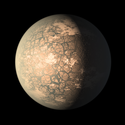TRAPPIST-1f
| TRAPPIST-1f | |
|---|---|
 Exoplaneta TRAPPIST-1f | |
| Identifikátory | |
| Typ | exoplaneta |
| Objeveno | |
| Datum | 22. února 2017 |
| Elementy dráhy (Ekvinokcium J2000,0) | |
| Perioda (oběžná doba) | 9,21 d |
| Mateřská hvězda | TRAPPIST-1 |
| Fyzikální charakteristiky | |
| Rovníkový průměr | 6 657,7 km |
| Hmotnost | 0,68 Země |
| Gravitace na rovníku | 6,08 m/s² |
| Povrchová teplota | |
| - průměrná | 219 K |
| - maximální | 1400 K |
TRAPPIST-1f je exoplaneta, též známá pod označením 2MASS J23062928-050228f v systému TRAPPIST-1. Je od nás vzdálená 41 světelných let. Tato exoplaneta obíhá v obyvatelné zóně. Jedná se o superzemi a pátou planetu v systému. Je to potenciálně obyvatelná exoplaneta.
Externí odkazy
 Obrázky, zvuky či videa k tématu TRAPPIST-1f na Wikimedia Commons
Obrázky, zvuky či videa k tématu TRAPPIST-1f na Wikimedia Commons
Média použitá na této stránce
Modified version of NASA Photojournal entry File:PIA21422 - TRAPPIST-1 Planet Lineup.jpg. Created for the TRAPPIST navbox template on the English Wikipedia. Planets have been spaced out to scale according to their orbital distances from TRAPPIST-1. Planet sizes are not to scale. Original Photojournal caption is as follows.
This artist's concept shows what the TRAPPIST-1 planetary system may look like, based on available data about the planets' diameters, masses and distances from the host star. The system has been revealed through observations from NASA's Spitzer Space Telescope and the ground-based TRAPPIST (TRAnsiting Planets and PlanetesImals Small Telescope) telescope, as well as other ground-based observatories. The system was named for the TRAPPIST telescope.
The seven planets of TRAPPIST-1 are all Earth-sized and terrestrial, according to research published in 2017 in the journal Nature. TRAPPIST-1 is an ultra-cool dwarf star in the constellation Aquarius, and its planets orbit very close to it.
They are likely all tidally locked, meaning the same face of the planet is always pointed at the star, as the same side of our moon is always pointed at Earth. This creates a perpetual night side and perpetual day side on each planet.
TRAPPIST-1b and c receive the most light from the star and would be the warmest. TRAPPIST-1e, f and g all orbit in the habitable zone, the area where liquid water is most likely to be detected. But any of the planets could potentially harbor liquid water, depending on their compositions.
In the imagined planets shown here, TRAPPIST-1b is shown as a larger analogue to Jupiter's moon Io. TRAPPIST-1d is depicted with a narrow band of water near the terminator, the divide between a hot, dry day and an ice-covered night side. TRAPPIST-1e and TRAPPIST-1f are both shown covered in water, but with progressively larger ice caps on the night side. TRAPPIST-1g is portrayed with an atmosphere like Neptune's, although it is still a rocky world. TRAPPIST-1h, the farthest from the star, would be the coldest. It is portrayed here as an icy world, similar to Jupiter's moon Europa, but the least is known about it.
NASA's Jet Propulsion Laboratory, Pasadena, California, manages the Spitzer Space Telescope mission for NASA's Science Mission Directorate, Washington. Science operations are conducted at the Spitzer Science Center at Caltech, also in Pasadena. Spacecraft operations are based at Lockheed Martin Space Systems Company, Littleton, Colorado. Data are archived at the Infrared Science Archive housed at Caltech/IPAC. Caltech manages JPL for NASA.
For more information about the Spitzer mission, visit http://www.nasa.gov/spitzer and http://spitzer.caltech.edu.Artist's impression of TRAPPIST-1f planet, as of 2018

